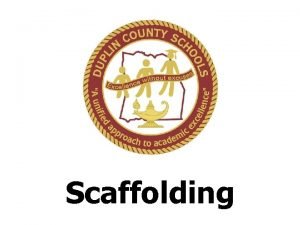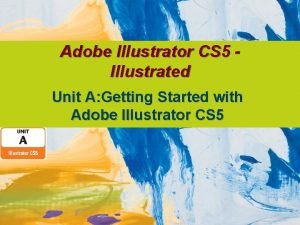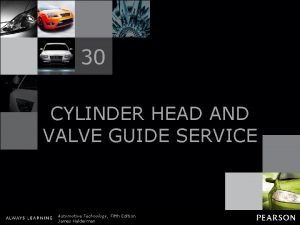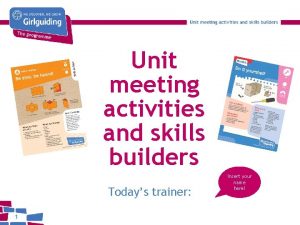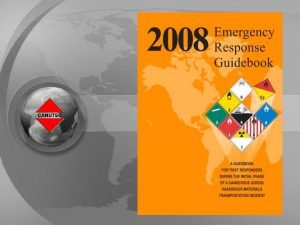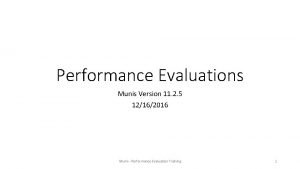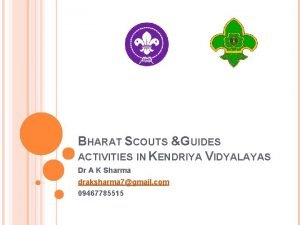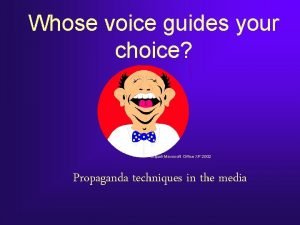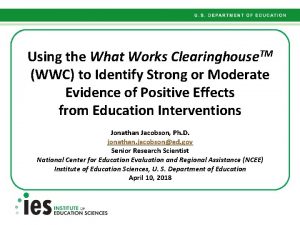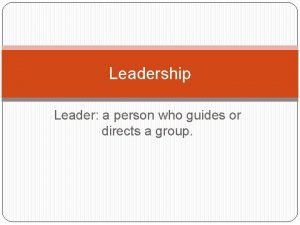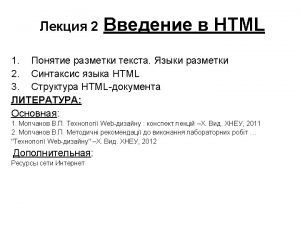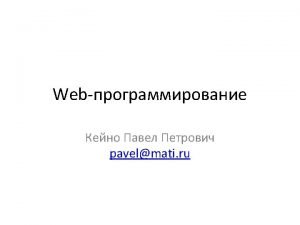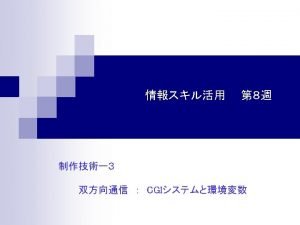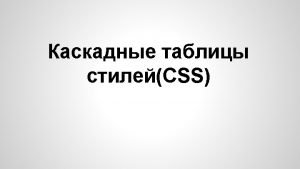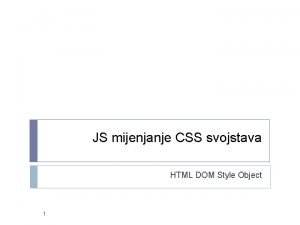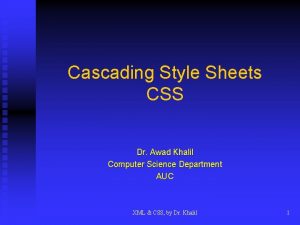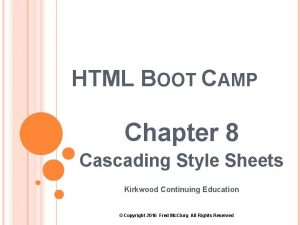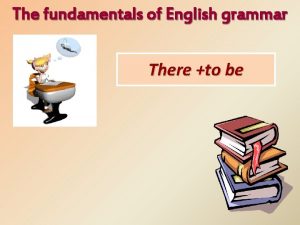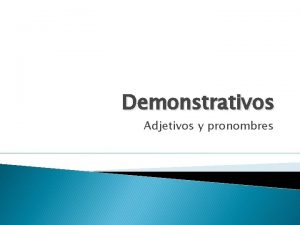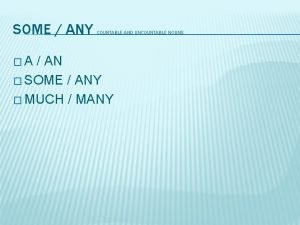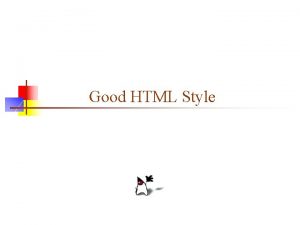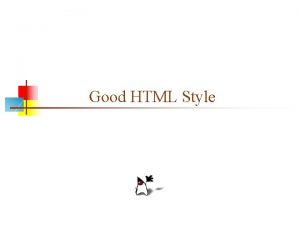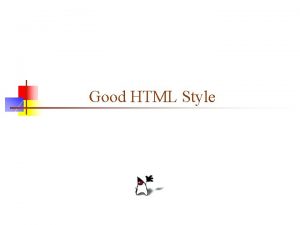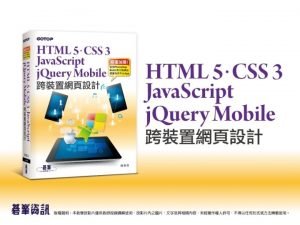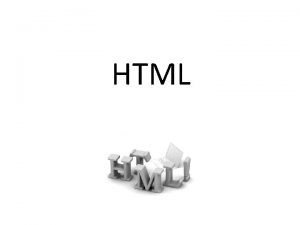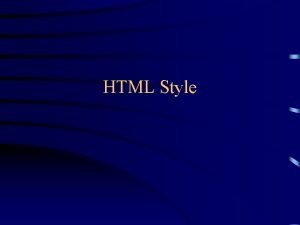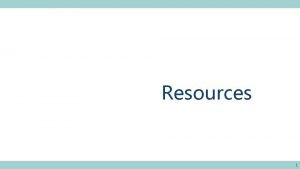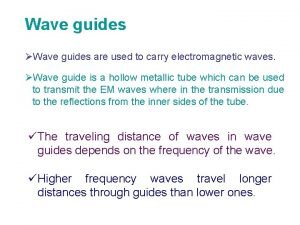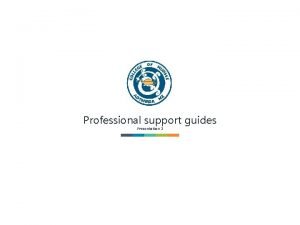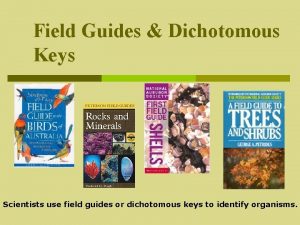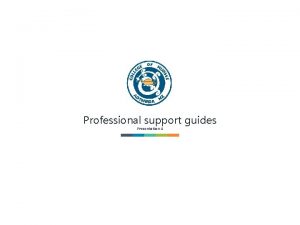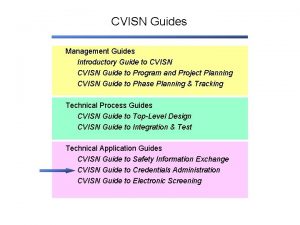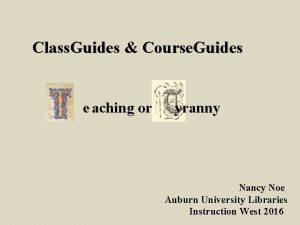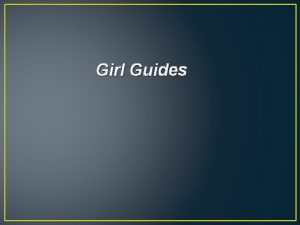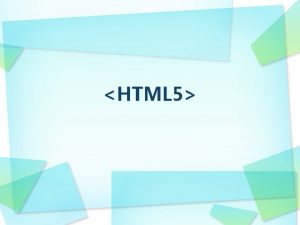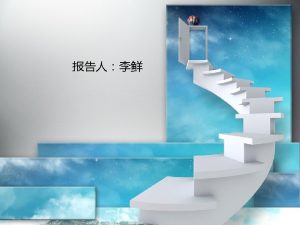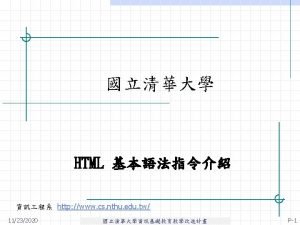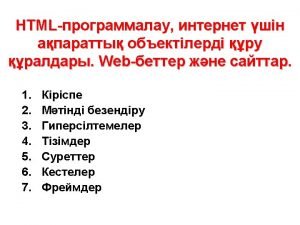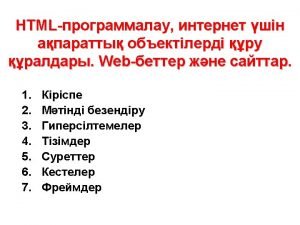HTML Style Style Guides There are many HTML


































- Slides: 34

HTML Style

Style Guides • There are many HTML style guides on the Web • One of the best is from Yale, http: //info. med. yale. edu/caim/manual/ – This talk is based on that style guide • Another is from the W 3 C, http: //www. w 3. org/Provider/Style/ • One of the more enjoyable sites is http: //www. webpagesthatsuck. com/ – Motto: “Where you learn good Web design by looking at bad Web design” • One of my favorite books on the subject: – Don't Make Me Think: A Common Sense Approach to Web Usability, by Steve Krug, Roger Black

Know who you’re trying to reach • What is your target audience? – The general public (Web surfers) • Like a magazine cover, your home page should lure people in – Use strong graphics and bold statements – In the fewest words possible, tell visitors what you offer – All your links should point “inward” to your pages – Occasional visitors • Navigation should be simple and obvious • Use overview pages, helpful icons, FAQs, and simple organization – Experts and frequent visitors • Provide well-organized information quickly with a minimum of fuss • Avoid fancy graphics, slow-loading pages, and “fluff” • Provide site maps and search facilities – International users • Use standard, easily understood language • Consider providing pages in a variety of languages • Avoid region-specific time and date formats, like 10 -12 -2002

Know what you’re trying to do • A page without a purpose is like a talk without a topic • Are you trying to sell something? – – Air freshener: Use beautiful outdoor scenes Underarm deodorant: Beautiful people (women and men) Computers: Attractive pictures and technical specs Yourself: See any book on writing resumes • Are you trying to convey information? – Use a clear organization with a table of contents – For many topics, a FAQ is often appropriate

New media require new formats • Books existed well before Gutenberg’s 1456 Bible • Here are some “interface standards” for books: – – – Books have covers Books are bound along the left edge (in the USA) The title is on the spine, top to bottom (in the USA) Books have a title page The pages of a book are numbered • Odd-numbered pages are on the right • The front matter is numbered with Roman numerals – Informative books have a table of contents and an index • How long after Gutenberg did it take to establish these standards? – Answer: Gradually, over more than 100 years

Web pages are not books • Standards are evolving rapidly, but are not “finished” • The Web brings new abilities: – Publishing is cheap; anyone can do it • "When I was a boy I was told that anybody could become President. I'm beginning to believe it. " - Clarence S. Darrow – Hyperlinks allow nonlinear access to information – Search engines make finding information much easier • I used to have hundreds of bookmarks; now I use Google • The Web brings new challenges: – Users can get “lost in hyperspace” • Good navigation tools are essential – Surfers flit on by, like TV “channel surfers” • You have maybe ten seconds to convey your message

Very general suggestions • Good writing was, is, and always will be important – Everything you ever learned about writing well still applies • Use a spell checker – Bad spelling puts off good spellers – Practically every piece of software includes a spell checker • Don’t use a grammar checker--they all stink – If you are not a native English speaker, they may point out some trivial grammatical errors – If you don’t see the reason for their advice, it’s probably wrong • Make each page stand by itself – You don’t know how someone got here – Don’t use page titles like “Introduction” that require context

Questions you should answer • The reader should be able to discover: – Who wrote the page? • You find a page on lung cancer. Was it written by (a) the American Medical Association, (b) someone who works for Philip Morris, or (3) a plumber in Hoboken? – What is the page about? • If you have nothing to say, don’t say it • Use a clear, short title--it may become a bookmark – When was the page written/updated? • You find a page about a great new drug available “next month” • Another page describes the “latest version” of some software – Where is the page? • Who wrote the page? Who sponsors it? • If I print the page out, will I ever find it on the Web again?

Build clear navigation aids • When someone accesses your site: – What are they likely to be looking for? – How sophisticated are they? – Hardly anyone does enough user testing • A common problem: you find an interesting page, but you don’t know what pages “surround” it – – – Are pages organized in a simple and consistent way? Can the visitor find her way to the home page? Can the user tell if she’s still in the same site? Button bars are good, but don’t omit text links Avoid dead-end pages (those with no links)

Help visitors find pages in your site • If you have many pages, you can use menu levels. . . – Look at the table of contents in a textbook; usually, there are main section headers, with subheaders • . . . but users do not like lots of little menus – Studies show that users prefer dense menus with lots of choices over little, one-step-at-a-time menus – “Site maps” (basically, an extensive table of contents) have become popular • Not everyone loads graphics by default – Image maps are nice, but keep the text links anyway – Think about making pages available to the disabled • Consider adding a search engine to your site • Don’t make it easy to accidentally leave your site – Distinguish between local links and links that take the visitor offsite – Give your pages a consistent “look”

Put the important stuff on top • Web pages are usually bigger than the window they are viewed in – The first thing visitors see is the top of your Web page – Many visitors will never scroll down • The top of a page should tell visitors what they need to know about the page – If a visitor is lost inside your site, she may notice links at the bottom of the page – Often, links at top and bottom are a good idea • This is especially true for a linear set of pages, where the links are Previous, Next, and (maybe) Home or Table of Contents

Organize your pages • Any organization is better than no organization • A hierarchy (tree) usually works best – Put most important or most general concepts near the top – Lower pages are more specific • Trees shouldn’t be too deep – Users don’t like to step down through multiple pages to find the one they want • Trees shouldn’t be “flat” – Users don’t like to wade through a huge list of links to find the one they want – Example: The CIT 597 home page • Though I do have a “table of contents” at the top • Draw a picture of your site!

Other organizations • Grid: HTML XSLT Lecture http: //. . . Links http: //. . . Assignment http: //. . . • Linear: – Pages to be read in order, with Previous and Next links – This design is most often seen in tutorials, or in fiction

Graphics on your home page • The “home page” is your intended starting point for visitors to your site – Nice graphics make your page look better – Complex graphics make your page load more slowly • Who is your target audience? – Potential clients • Appearance is important. . . • . . . but most users won’t wait more than 7 or 8 seconds for a page to load – Existing clients, students, employees • Getting information quickly is most important

Updating sites • Many types of sites must be updated frequently – Using a New! graphic may help point out changes • But how long does an item remain “new”? • Dates on items are more informative – If information is spread out over many pages, a central What’s New page may be a good idea – I typically put dated announcements at the top (good) and add material at the bottom (maybe not so good)

FAQs • For many sites a FAQ (Frequently Asked Questions) page, with answers, is very helpful – A FAQ is especially helpful to beginners in an area – The current best site seems to be http: //www. faqs. org/ • Biggest problem with FAQs is that many of them are “fakes” – A company puts out a FAQ about its product that obviously doesn’t answer questions from real users • “What is the biggest benefit of using XYZ hair spray? ” – Don’t lie to your customers!

Design standards • Without question, a company should have design standards for company Web pages – Problems: • Established groups and individuals have already developed their own standards and are reluctant to change • The wrong people may be put in charge of defining the design standards – They may know little or nothing about existing standards – They may decide on “too many” standards--things that may be a good idea individually, but don’t work well together – They may take forever to finish, so standards are coming “any day now” – They have their own goals, and ignore or forget the user

Site “covers” • A site cover is a page that comes before the home page – Typically, they just add another mouse click and waste the user’s precious time – If it doesn’t add any value, users don’t want to see it more than once • An informational site, such as a newspaper, can have a cover that provides links to the various sections • A reference site, such a s Yahoo!, should “have its menu posted on the front door” • A handsome site cover may add interest to an art or entertainment site

Design principles • In The Non-Designer’s Design Book: Design and Typographic Principles for the Visual Novice, Robin Williams discusses these four principles: – Proximity: Related items should be grouped together – Alignment: Nothing should be placed on the page arbitrarily--every item should have a visual connection with something else on the page – Repetition: Some aspect of the design should be repeated throughout the entire piece – Contrast: If two items are not exactly the same, make them different--really different.

Proximity • Proximity--nearness--is your best tool for organizing things on a page – If things are close together, they appear to be related – Therefore: • If things are related, they should be close together • If things are not related, they should not be close together – – Avoid spacing everything equally Don’t stick things in the corners or alone in the middle of a page Avoid having too many groups on a page Make sure headers look like headers, and things that aren’t headers don’t look like headers

Alignment • Alignment is literally “lining thing up” – Good alignment helps to unify and organize the page – You want to avoid the “scattered all over” look Left alignment tends to happen naturally in Web pages Right alignment is not generally as useful Center alignment tends to be boring, and is especially ugly when the lines are all about the same length anyway – Try to avoid more than one kind of alignment on a page

Repetition • The purposes of repetition are: – To unify the page or group of pages – To add visual interest • Few things look more boring than long, unbroken pages of text • Things that look boring often aren’t given a second look • Repetition is like consistency, only more so – You probably already try for consistent fonts, headers, etc. – Some visual elements--backgrounds, icons, borders, horizontal rules--should be repeated throughout a Web page, or a related group of Web pages – If your pages belong together, they should appear to belong together – However, don’t use so much repetition that it becomes annoying

Contrast • • • Contrast is when two elements are clearly different You can create contrast by using different sizes of type You can create contrast by using different kinds of fonts You can use thin lines and thick lines You can use horizontal lines and vertical lines You can use contrasting colors: cool (bluish) and warm (reddish) colors • You can use widely spaced text and closely spaced text • Don’t be a wimp--make different elements really different • There isn’t much contrast between 12 -point type and 14 point type

Contrast II • Contrast is when two elements are clearly different • You can create contrast by: – – – Using different sizes of type Using different kinds of fonts Using thin lines and thick lines Using horizontal lines and vertical lines Using contrasting colors: cool (bluish) and warm (reddish) colors Using widely spaced text and closely spaced text • Don’t be a wimp--make different elements really different – There isn’t much contrast between 12 -point type and 14 -point type!

Types of fonts • Serif Fonts • Sans serif fonts -- no serifs • Monospaced fonts -- all characters are the same width • Display fonts -- not intended for lots of text • EVEN IN A GOOD FONT, LARGE AMOUNTS OF TEXT IN ALL CAPITALS IS DIFFICULT TO READ

A few more simple principles • Establish a visual hierarchy – People first see the graphics, then the text – Balance, organization, and visual contrast are vital • Direct the reader’s eye – People scan text left to right, top to bottom – Only the top four inches may be visible – Use pastel shades for backgrounds or minor elements • Beware of distractions – Garish illustrations and (especially) animated graphics or blinking text pull the user’s eyes away from the content – If everything is emphasized, nothing is emphasized • Be consistent – Don’t have things scattered all over your page – Let your style “evolve” as you improve the page

Establish a consistent look • Every page on your site should share some style elements with all the other pages – The idea is that the user should know, without thinking about it, that she’s still in the same site – Use the same logo, or the same set of navigation buttons, on every page – Use a consistent color scheme and set of fonts • Your pages don’t have to all look identical (and shouldn’t), but they should have a common style • CSS style sheets can be a big help in defining a consistent look – But you need to test them on a variety of browsers

Legibility and readability • Readability: How easy it is to read a lot of text • Legibility: How easy it is to read headlines • In general, a serif font is more readable (in medium sizes) • Because of the coarse resolution of modern screens, a sans serif font is more readable in small sizes • Very high contrast (difference in brightness, not color) makes text more readable • Do not change the default size of body text; the user has it set to the size she wants – Increasing the size for headers or for emphasis is OK • Don’t use more than a couple of different fonts – Usually, one serif font and one sans serif font is enough

Use tables • HTML <table>s are your best tool for arranging text and graphics on a page – For simply arranging things, use tables without borders – Use borders if you want it to look like a table – Don’t use pixel values for heights and widths--that takes too much freedom away from the user • Use percentages instead

Types of graphics • There only three kinds of graphics you can use on the Web: – GIF (Graphics Interchange Format) • Good for pictures with only a few colors • There are some legal problems involved – JPG or JPEG (Joint Photographic Experts Group) • Good for photographs – PNG (Portable Network Graphics) • Modern, fancy, good for everything • Not supported by older browsers

GIF files • GIF is the most common file format – You can specify, in a GIF file, how many colors to use (2, 4, 8, 16, etc. ) • The fewer colors, the smaller the file • This is great for charts, cartoons, etc. – GIFs are lossless--you can exactly recreate the original image – GIFs can be animated – GIFs can be interlaced • This allows pictures to appear quickly and get sharper – GIFs can have a transparent color • This lets you use arbitrary shapes on any background – UNISYS owns the patent on GIFs, and has tried to make people pay for using them

JPG files • JPEGs provide a superior compression scheme when there are color gradients in the image – That is, for every photograph – JPEGs are lossy-- some information is lost in the compression, and the information is interpolated (faked) when the picture is recreated – You can set the compression ration--the more compression, the smaller the file, and the more information is lost – JPEGs do a very good job of recreating photographs – JPEGs don’t do a good job of recreating diagrams and line drawings

PNG Graphics • PNG has three main advantages: – Alpha channels: you can have variable (partial) transparency – Gamma correction, so you can get the same colors on different platforms – Two-dimensional interlacing • PNG also provides: – Better compression than GIF – A less convenient way to do animations – No legal hassles

The End
 Mikael ferm
Mikael ferm Define anticipation guide
Define anticipation guide Act 2 othello summary
Act 2 othello summary Libguides unisa
Libguides unisa Iuss standards
Iuss standards Strategic planning in retailing chapter 3
Strategic planning in retailing chapter 3 How to change artboard units in illustrator
How to change artboard units in illustrator Integral valve guide
Integral valve guide Association of ukrainian guides
Association of ukrainian guides Unit meeting activities guides
Unit meeting activities guides Erg orange section
Erg orange section Munis training manual
Munis training manual Scout and guide law
Scout and guide law Whose voice guides your choice
Whose voice guides your choice Wwc practice guides
Wwc practice guides God guides me
God guides me Person who guides or directs
Person who guides or directs Doctype html html head
Doctype html html head код страницы html
код страницы html Head body html
Head body html Bhtml?title=
Bhtml?title= Doctype html html head
Doctype html html head Html dom style object
Html dom style object Change font style in html
Change font style in html Booty camp chapter 8
Booty camp chapter 8 There is there are ejemplos
There is there are ejemplos There is there are part of speech
There is there are part of speech There is there are negative form
There is there are negative form There is ve there are
There is ve there are There isnt any cheese
There isnt any cheese There is there are
There is there are Eight dollars the price of a movie these days
Eight dollars the price of a movie these days Here there over there
Here there over there Some any countable uncountable
Some any countable uncountable Contables e incontables
Contables e incontables

